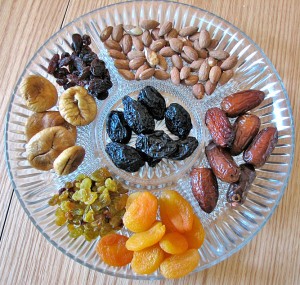Tu means 15th; B’Shevat means of the month of Shevat. This was the date originally designated as the general birthday of all the trees that provided food in Israel no matter when in the year they were actually planted. It should come as no surprise to you that this minor holiday deals with food and wine.
In Israel, at this time, it is ‘mid-winter’, the rains are decreasing, leaving good soil to plant trees. Fruit trees were awarded special status in the Torah because of their importance in sustaining life and as a symbol of Hashem’s divine favor. The date of Tu B’Shevat was used for the counting of the years of fruit trees to follow the traditions of harvest set out in the Torah (first three years of fruit-harvest is forbidden, fourth year the fruit of that harvest is gathered and offered to priests as a gift of gratitude to Hashem. It wasn’t until the fifth year that the fruit harvest was actually the farmer’s yield.)
These fruit trees are considered so important that in the Torah there is a warning to the Israelites from Hashem, that during war you must not destroy fruit trees in order to capture a city by besieging it. Only trees that do not yield food may be destroyed. (see Deuteronomy 20:19-20) It was later that the rabbis designated this as a holiday of the New Year of the Trees.
More spiritual significance to this date was given by the Kabbalists to provide new religious significance along with new symbolic rituals (including incorporating the Tree of Life, aka the map of Sephirot). Fruit or nuts hide within themselves the seeds of new life and potential growth, as all physical forms (including humans) hide within themselves a spark of the Divine Presence. From this came the tradition on Tu B’Shevat, to eat certain fruits associated with the land of Israel as a symbolic way of releasing these divine sparks.
The Tu B’Shevat Seder was developed in the 16th century. In modern times, Tu B’Shevat also became a symbol of Zionist attachment to the land of Israel as well as sensitivity to the environment. Planting new trees restored ecology of ancient Israel, but also became a symbol of renewed growth.
 Today the Tu B’Shevat seder incorporates at least 12 fruits: wheat (as the basis for our sustenance), olives, dates, grapes, figs, pomegranates, etrogim, apples, walnuts, almonds, carobs, and pears; and 4 cups of wine, with blessings and discussions ranging from Kabbalistic traditions, and ecological interpretations, to Zionism. If you wish to see more on the Tu B’Shevat Seders explore the Chabad, Aish, or My Jewish Learning Websites. Or for a child’s perspective, visit the PJ Library Tu B’Shevat site.
Today the Tu B’Shevat seder incorporates at least 12 fruits: wheat (as the basis for our sustenance), olives, dates, grapes, figs, pomegranates, etrogim, apples, walnuts, almonds, carobs, and pears; and 4 cups of wine, with blessings and discussions ranging from Kabbalistic traditions, and ecological interpretations, to Zionism. If you wish to see more on the Tu B’Shevat Seders explore the Chabad, Aish, or My Jewish Learning Websites. Or for a child’s perspective, visit the PJ Library Tu B’Shevat site.
Besides the traditional Tu B’Shevat seder one could incorporate any of the above foods in your celebratory meals. Try them in spreads (such as olive tapenade), hors d’oeuvres (try dates stuffed with goat cheese), various grain crackers or muffins. Use them in soups, salads, sides, and more (of course, not forgetting the grapes in the wineglass). For some good ideas and recipes you might want to explore the Tu B’Shevat websites of Tori Avey or Jammie Geller.
Either way, when you celebrate Tu B’Shevat, use these foods to add to the appreciation of the holiday.
Shalom —Janet Stein-Larson






